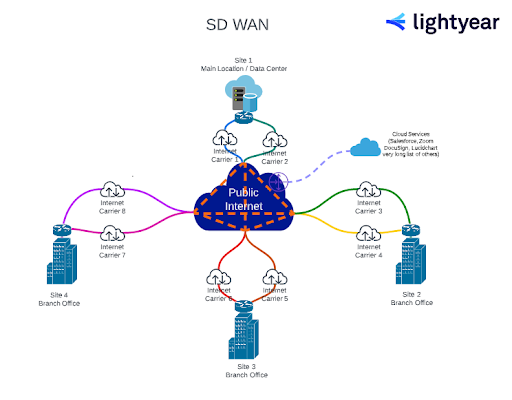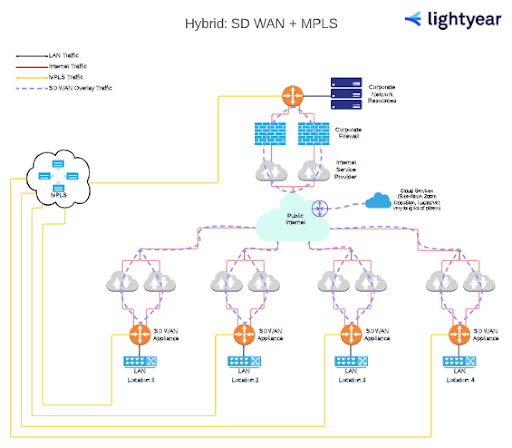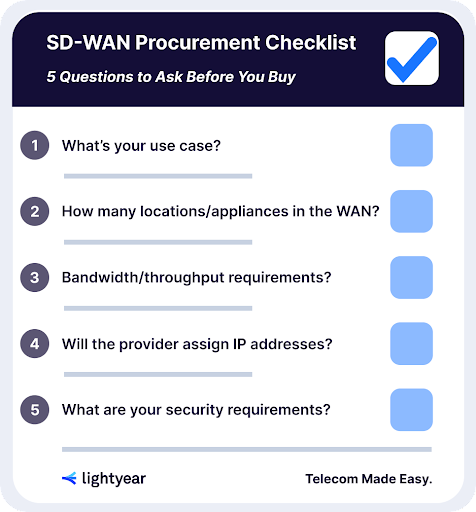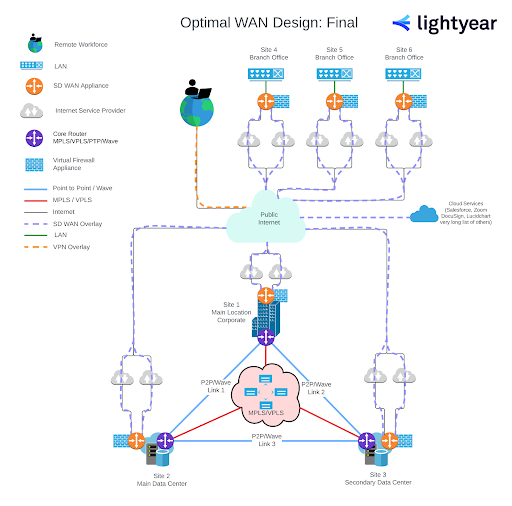SD-WAN Buyer’s Guide: Key Features and Pricing Factors
Not sure where to start with your SD-WAN vendor selection and needs analysis? Read this guide for some guidance on where to begin evaluations.

Jul 28, 2022
SHARE
If you’ve been tasked with estimating the SD-WAN cost of a revised WAN architecture for your company and have been stuck scratching your head in confusion, then you’ve come to the right place. SD-WAN is priced in many different ways, so honing in on an adequate estimate begins with understanding software-defined wide-area networking (SD-WAN) in the context of your organization’s needs for WAN edge infrastructure. But first, let’s start by defining SD-WAN.
Software Defined Wide Area Networking (SD-WAN) is a software-based architecture that acts as a virtual overlay to an underlying hardware-based network and provides a centralized control function to efficiently steer traffic across a WAN based on an enterprise’s business needs. By enabling traffic prioritization, SD-WAN can support many of the same quality-of-experienceand security benefits of MPLS or P2P for important applications albeit with easy-to-use centralized software controls. Also, for the most part, SD-WAN data transmission occurs over the public internet rather than on preset or dedicated routes, making it potentially significantly cheaper than MPLS or P2P architectures.

With centralized control an SD-WAN enables IT to prioritize traffic over the public internet.
A key difference when comparing SD-WAN vs. MPLS is that SD-WAN acknowledges the public internet as arguably the most important node on the enterprise WAN. One of its advantages over MPLS—along with flexibility, cloud-readiness, resiliency, carrier diversity, and transparency—is the potential for significant cost savings. There are some disadvantages too and I encourage you to take a look to help you choose the right SD-WAN solution for you.
The potential opportunity to do more with less budget and foster ongoing cloud transitions has got enterprise IT leaders’ attention spurring the growth of the SD-WAN market.
According to this IEEE ComSoc Technology post summarizing the Gartner 2021 Magic Quadrant for WAN Edge Infrastructure—there’s been a big move to SD-WAN technology from MPLS-based customer edge routers in the last several years. This can be seen in the growth of SD-WAN (18.0% CAGR) over traditional branch office routers (-16.5% CAGR), per Gartner’s September 2021 report.
Clearly, the advantages are compelling, but when you are pricing SD-WAN options, it can be very difficult to compare costs given the lack of standardization around pricing models.
No Standardization Complicates SD-WAN Pricing
As of the posting of this article, there is no widely accepted referenced standard for what SD-WAN even is. The Metro Ethernet Forum (MEF) took the lead and came up with MEF 70 in July 2019 to define SD-WAN Service Attributes and Services and then made an update to MEF 70.1 in November 2021. MEF 3.0 SD-WAN certification validates service and technology partners conform to the MEF 70 standard. This standard and certification is not widely accepted. As a point of reference, in September 2021, Gartner produced a Magic Quadrant that compares 15 of the market leaders’ WAN Edge solutions for SD-WAN. A cross examination of these 15 technology providers against MEF 3.0 SD-WAN certification shows that only 8 of the 15 providers reviewed are listed on MEF’s 3.0 SD-WAN certified technology supplier companies. As of the posting of this blog, there are only 20 fully certified MEF 3.0 SD-WAN Certified Technology Supplier Companies. A very quick internet search for SD-WAN equipment will provide a list of results that will scroll for several pages and you’ll quickly realize that 20 suppliers are just the tip of the iceberg.
Due to the lack of a widely accepted standard, there are large variations between SD-WAN solutions. The large variations between what each solution provides makes it challenging to compare the solutions in a fair “apples to apples” comparison. This leads to a complex process that should start with a buyer taking the time to analyze their business’ needs. After the needs analysis is completed, the search for a SD-WAN solution can be streamlined by limiting the evaluation to only include solutions that meet your requirements.
Here are a couple of previous blogs we’ve published that can help you with this component of the process:
To help you get your bearings on appliance vs. platform, vs. integrated provider approaches we’d recommend taking a look at this post: SD-WAN for Dummies: 2022 Buyer’s Guide.
A La Carte or All You Can Eat?
To elaborate further on the SD-WAN buyer’s dilemma: sitting at opposite ends of the SD-WAN spectrum are hardware-only solutions and holistic (or hybrid) solutions. Some solutions exclusively offer SD-WAN hardware appliances for site-to-site connectivity while others offer a holistic cloud-based platform with appliances at the edge, the option for virtual appliances, and a middle-mile network with gateways that efficiently route cloud-based applications to the appropriate service provider. When comparing the SD-WAN cost of hardware-centric solutions against holistic / hybrid services you will see a significant pricing delta, and the huge difference in overall offering noted above is the primary source of it.

Holistic/hybrid SD-WAN platforms offer all the bells and whistles as a cloud-based service.
So, before you can vet SD-WAN providers’ solutions, the first step is to understand what the requirements are for your SD-WAN. How do you want your traffic to travel? And then you can take the next step and look at the features and functionalities individual vendors have included in their SD-WAN solutions.
The premise behind this procurement process is knowing where to begin. Start by reading this SD-WAN Procurement Checklist blog. Knowing the answers to these questions will help you identify the best-fit solution for your needs.

Table Stakes: Where to Begin With SD-WAN Pricing
In case you missed it being noted 10x above, SD-WAN standardization is not the best. This makes the task of comparing SD-WAN appliances and service offerings crucial. However, there are a few things that everyone is OK with across the board. (BREATHE). In order to get to a true “what does an SD-WAN cost?” estimate you have to:
Qualify your needs to single out the vendors that support them. This step is crucial to ensure that you’re coming as close as possible to comparing apples to apples.
Start comparing pricing (which is quite difficult) between the solutions that fit your organization’s needs.
Here are some common characteristics of an SD-WAN network deployment. You can use these as a starting point for your organization’s SD WAN evaluation.
Site-to-site communications:
One of the core use cases for an SD-WAN deployment is the ability to use it as a suitable replacement for MPLS traffic.
Most SD-WAN deployments include the ability to establish secure site-to-site transmissions. This is (perhaps) one of the first elements that draw people to an SD-WAN deployment. They’re almost always used for physical site-to-physical site, physical site-to-data center/colocation, or physical site-to-cloud applications.
Carrier agnostic:
Most SD-WAN appliances/networks are “carrier agnostic,” meaning, it doesn’t matter who the internet service provider is. The SD-WAN functionality takes place “over-the-top” of the internet underlay.
Why is this important?
If you have existing internet service with contractual time left, it’s important to ensure that the SD-WAN appliance isn’t tied to any specific carrier’s network.
It’s also a standard SD-WAN deployment architecture to leverage “carrier diversity,” meaning, you order (at least) two circuits from different internet service providers (ISPs). It is very rare that an ISP has a massive outage, but it does happen. It’s exponentially rare that two ISPs have an outage at the same time.
MPLS-centric:
There are several reasons that organizations might need to retain an MPLS network. If your organization requires MPLS as part of the SD-WAN solution it’s important to ensure that the SD-WAN provider’s deployment supports MPLS. Here are a couple of typical reasons that MPLS would need to remain:
Your organization runs applications that require MPLS for security, compliance, or prioritization purposes.
Your organization has an existing MPLS network that’s still under contract with time left. Organizations should continue to utilize these links if they’re still paying for them.
If MPLS is required, ensure that the SD-WAN vendor’s deployment supports both internet and MPLS circuits into the same environment. In SD WAN deployments all traffic is typically treated as sensitive data. In deployments that have MPLS requirements, typically the highly sensitive traffic is routed over the MPLS circuit and the less sensitive traffic is encrypted and then routed over the public internet.
Hardware appliance or virtualized:
In most cases the SD-WAN solution is a hardware appliance that is installed at the network edge. There are several providers that offer a virtualized instance of their SD-WAN appliance. Virtual appliances are almost always reserved for data centers (i.e., a hosted server farm.)
Fortinet Secure SD-WAN, for example, has the FortiGate hardware and also the virtualized appliance. The FortiManager dashboard gets you to the virtualized instance of the FortiGate appliance that has the SD-WAN features.
Middle-mile network:
Simply put, a middle-mile network is a provider-created network that lives between the last mile and the internet peering/transit.
In many cases, providers configure the middle-mile network to be Layer 7 aware. This allows for prioritization and optimized routing for things like: voice and video calling, popular web hosted applications like Salesforce, and better routing to cloud providers like AWS and Azure.
Encryption:
Data is almost always encrypted before it goes across the internet between multiple sites.
Most SD-WAN appliances create some version of a VPN tunnel between sites and pass the encrypted traffic back and forth (not all but most do this).
OSI Layer 7 application awareness makes several things possible:
Prioritized routing based on the type of traffic is extremely useful; for example, VoIP traffic vs. streaming video content on YouTube. Standard profile configuration is implemented so that VoIP traffic would have preferential treatment if the network experiences congestion.
Volume and utilization of circuits is table stakes at Layer 3 visibility. With Layer 7 visibility, several SD-WAN providers are able to provide detailed information on which applications are being used and which devices are using them.
Redundancy:
Almost all SD-WAN networks have the ability to take multiple WAN connections into the box (internet, MPLS) and prioritize traffic. But there are differences in how they handle load balancing and failover.
Two of the most prevalent network load balancing/WAN optimization methods at a packet level are flow based and packet based. There is enough information to write an entire blog on just this topic, but this isn’t where we’ll discuss it. The big takeaway here is that you need to ensure that you know how your business-critical applications function and how flow-based vs. packet-based failover will affect these applications.
Active/active topology: In an active/active scenario, at least two circuits are always-on so, if one goes down, the only data that drops is whatever was on the line at the time. This significantly lowers the impact that the end users experience.
Active/standby topology: In an active/standby scenario, if the active circuit goes down there is a brief outage while the SD-WAN device brings the standby circuit status to active, and then starts to send traffic across it. Active/standby is a popular topology when one of the circuits is a metered LTE circuit.
Customization:
After you finish taking a few initial steps to understand your business’s needs you’ll know if there is an SD-WAN topology that fits your needs.
If not, you’ll end up needing to find a flexible deployment method that can be customized to suit your individual needs. A lot of times, SD-WAN doesn’t have to replace your entire network. Rather, in a great many instances it can be one element of a much larger network.

SD-WAN can be part of a much larger, custom network deployment
An SD-WAN Guide to Vetting Vendors
Understatement: there are a lot of SD-WAN products and flavors to choose from. A critical first step is to figure out your SD-WAN needs relative to what you already have in place. For example, consider how your underlay network will support your SD-WAN overlay network and who is responsible for managing it. Factor in any existing contracts for services like MPLS so you can maximize your return on investment. For more on this, read the Transitioning from MPLS to SD-WAN guide.
While the industry lacks SD-WAN standards for vetting vendors, the 2021 Gartner MQ for WAN Edge Infrastructure has differentiated providers based on Gartner’s SD-WAN criteria. The same SD-WAN providers have come out on top for the last couple of years in the Magic Quadrant while the number of vendors who’ve met the criteria for being included has tripled since 2019.
SD-WAN offers many benefits that are driving adoption. Here are some of the key attributes of SD-WAN solutions to consider when comparing vendors side-by-side against your organization’s needs:
Ease of use: GUI—single pane of glass
Active/active vs. active/standby
Flow-based
Packet-based
Firewall with SD-WAN features
Firewall with purpose-driven SD-WAN and security
Security
Secure Access Service Edge (SASE)
Monthly licensing fees
CAPEX purchase equipment/licensing for term
OPEX monthly operating expense
Managed service versus managed in house
So, What Will SD-WAN Cost You?
Once you know your general needs you can begin the process of vetting out potential SD WAN solutions. The process can be overwhelming, especially if you are going down this buyer’s journey for the first time. You may not know exactly what you need or how to go about matching your needs to a solution provider. This is where Lightyear can help. Using Lightyear’s automated procurement platform will accelerate the process for your business. Lightyear will help your business through needs analysis, vendor selection, cost analysis, and procurement.
Lightyear’s data- driven software has helped hundreds of enterprises evaluate, procure, and implement SD-WAN in an efficient, automated process. We have a team of telco experts on standby to answer any questions you have throughout the process and a wealth of blogs they’ve written on the topic. If your enterprise would like some (free) assistance on making the transition to SD-WAN, submit a demo request with us here.
Want to learn more about how Lightyear can help you?
Let us show you the product and discuss specifics on how it might be helpful.
Not ready to buy?
Stay up to date on our product, straight to your inbox every month.
